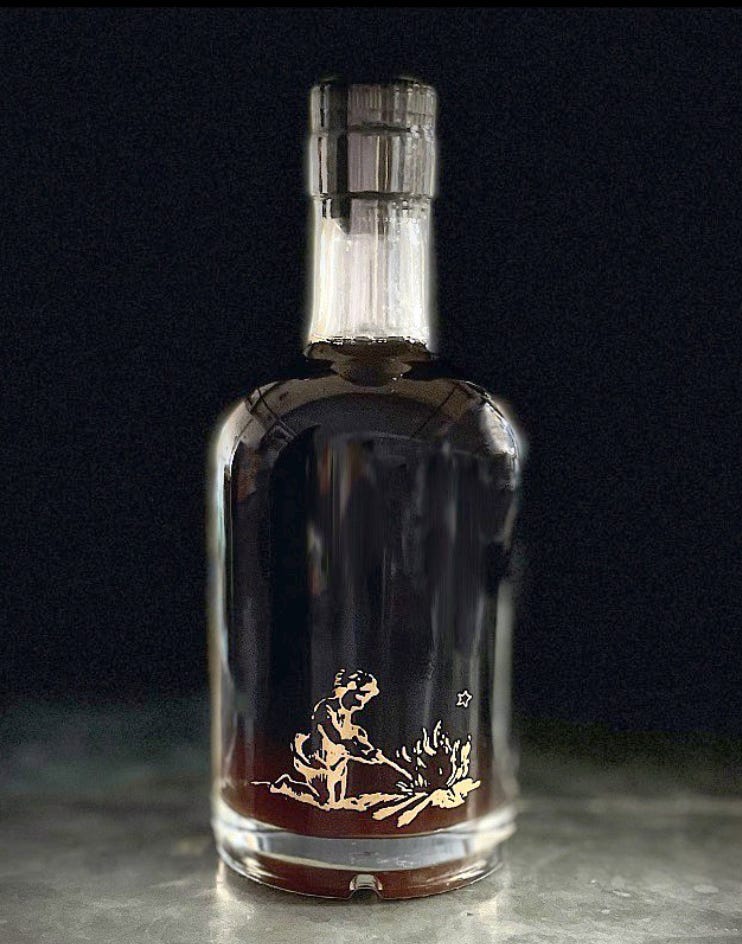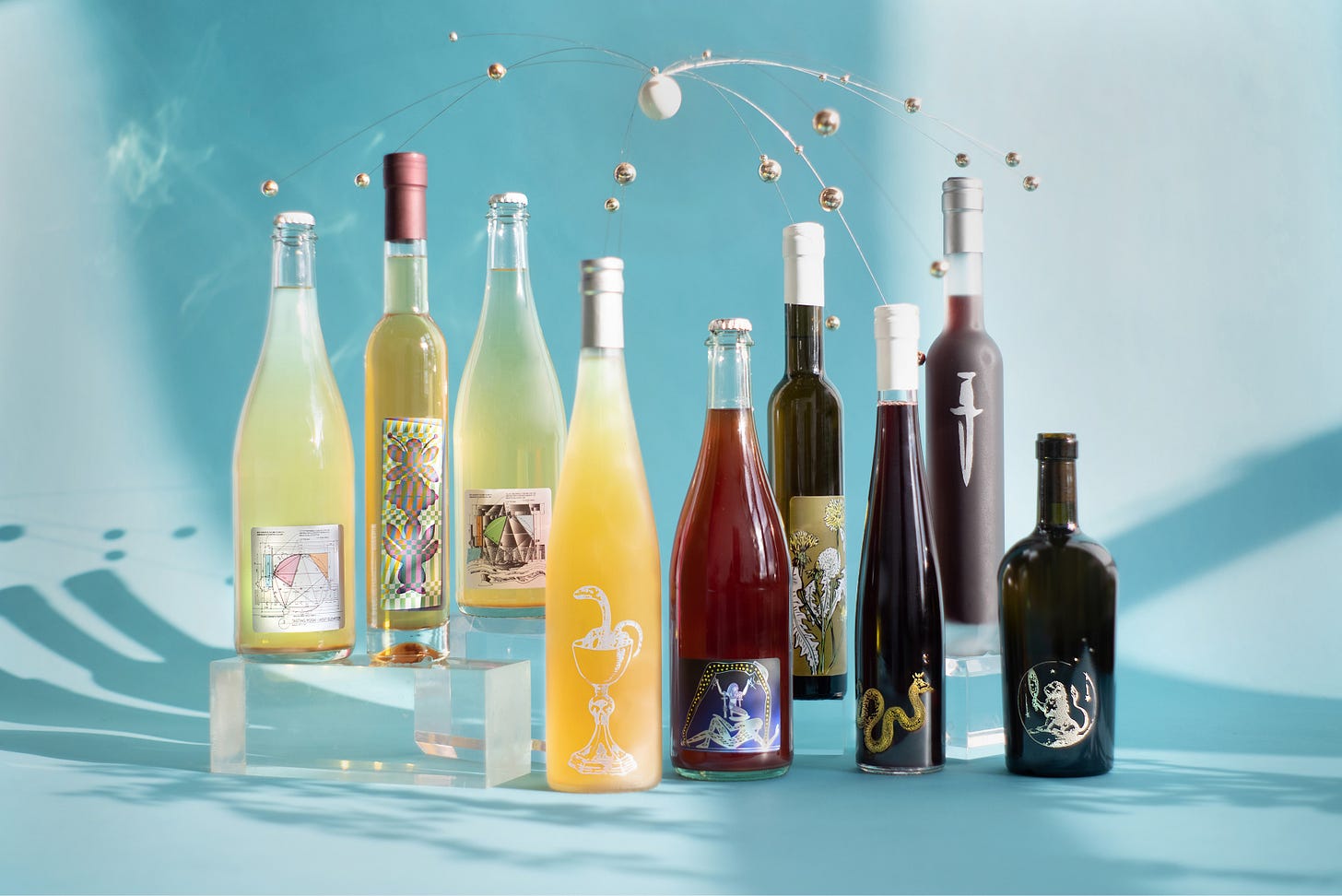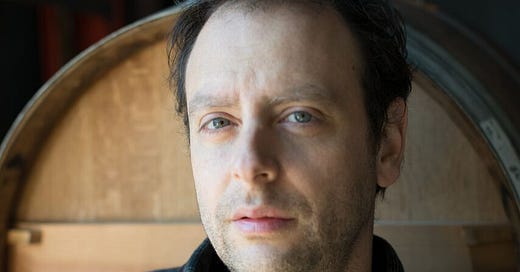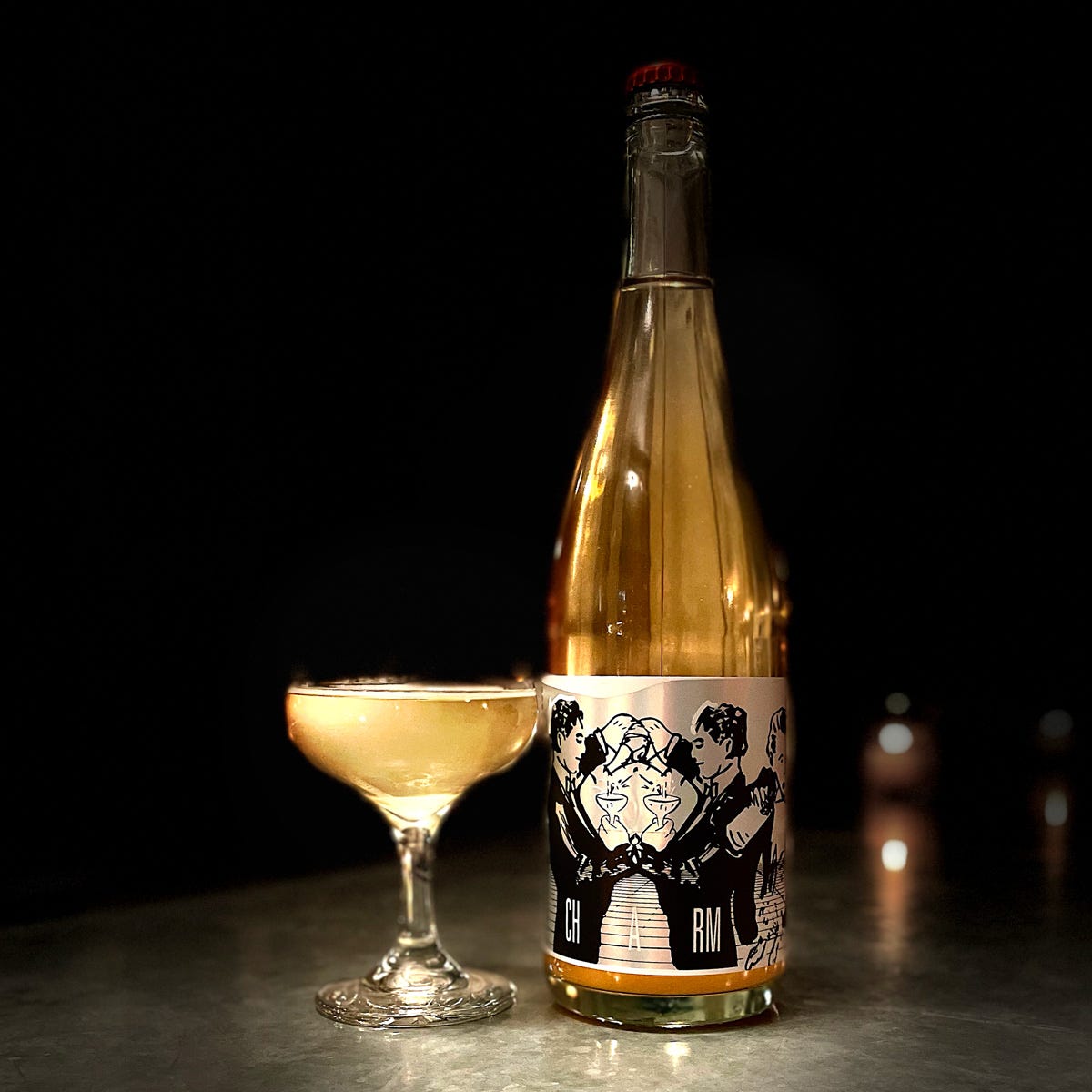The Fizz #65: Raphael Lyon of Enlightenment Wines embraces fermentation as preservation
In this issue, Raphael and I talk through how he makes meads, the state of United States bees, and how the history and tradition of mead-making inspires him.
For the 65th issue of The Fizz, I spoke to Raphael Lyon, founder and winemaker of Enlightenment Wines, specializing in artisan meads out of Brooklyn, NY. I’m fairly new to meads, and when I tasted his wines at the recent Peripheral Wine Fest in the Hudson Valley, I was amazed. The meads were dry, rich, herbal, interesting, and woke up that feeling I get when I really connect with something—a wine that brings you back to the land in each sip.
In this issue, Raphael and I talk about how mead is made, how honey is only a byproduct for many commercial United States apiaries, and where he finds inspiration for making meads with local New York honeys, fruits, and herbs. I’m so excited to taste more of these incredibly complex beverages, presenting the diversity of winemaking in the United States.
Margot: I read somewhere that your family had a homestead growing up. Is that right?
Raphael: Yeah, it was a farm where we grew most of our food, but not all of it. We weren't commercial farmers—we weren't selling produce, but we lived on what was a farm or at times a ranch. I still pine for the fact I simply can't buy a good tomato here [in Brooklyn].
What's interesting is that location in upstate New York, my family sold it quite a while ago, but because my license was there, we continue to rent and there's a new family there who's more my age and we're quite friendly and it's been nice to see their kids grow up there at the same spot.
Margot: Was mead a part of your experience growing up?
Raphael: No, not at all. My family didn't really drink at all, and so we didn't really have a culture of drinking. We had a good food culture. My stepmother was a great chef and I learned a lot about herbs from her. She was an amateur herbalist, but very serious about it.
I didn't really start making alcohol until I returned as a semi adult in my early twenties for a year in 2000 to really try and participate as—they would call them sort of “preppers” now, but that word didn't exist back then. I was interested in self-sufficiency. I was involved in anti-GMO activism and I was really excited about seed saving and heirloom plants and none of this was in popular culture at all yet.
There was just literally no conversations about this stuff outside of a very niche either activist or farmer community. I was sort of tapped into that. I was interested in foraging and a lot of plant identification, and alcohol making is sort of a natural outgrowth of those interests.
Margot: Did that interest start from a place of preservation?
Raphael: Absolutely. I mean, partially, it was sort of like a punk thing, you know, I just kind of identified as an outsider person who wanted to try and make a life without cash. We didn't really use a lot of money. We needed money to buy some stuff, but basically we grew our own food, so we didn't really need a lot of cash. We were spending most of our money on beer.
Learning to make alcohol was an important part of that time for me. When you go into it from that perspective, I never thought I wanted to be a winemaker or grow grapes—that was just the farthest thing from my head. I thought, oh, you can make alcohol out of apple juice from the store and cranberry juice, add sugar to it and start from there. So that's interesting.
Margot: Were you influenced by your stepmother coming up in her herbal education or your life on the farm, or did that come later?
Raphael: Definitely. She was already making tinctures and identifying wild plants. That was a cool inspiration for me. When I came back to the farm, there were books that she had that I could borrow. Susun Weed was an important herbalist for that area, that generation. Stalking the Wild Asparagus is a classic book from that generation. There's a huge number of books being produced now, but at the time there wasn't really much. It wasn't like you could just go on the internet look stuff up.
I didn't do my research on the internet. It's probably why I'm a good winemaker. If you really wanted to learn how to do this, Better Homes and Gardens produced an incredible book for homesteaders. It had everything from how to have pigs and how to make wine, to how to make a basket. There's just a huge amount of noise that's being recirculated on the internet. The people who wrote these articles, researched them and really were providing some kind of wisdom. It was helpful and inspiring.
Between those two things, foraging and herbal books and basic winemaking techniques, I had enough information to start to teach myself how to do it.
Margot: Did you start with honey or did you start with grapes or other fruit?
Raphael: I didn't start with honey. I really was thought of myself as a fruit winemaker at first—fruit and herbs, because there was lots of fruit to be had. I lived in this region which had apples and cherries and all this kinda stuff. We picked some fox grapes, now that I think about it. I did work with some wild grapes, you would add sugar to it to bring the Brix up so that you'd have some kind of stable product.
In practice after a year or so, I realized I could use honey and it would just taste a lot better. This was before there were a lot of meaderies around. I hadn't really heard that word. I soon came to understand what I was doing was really making mead.
Margot: I feel like it's more common in New York State, especially the Hudson Valley, to start with fruit that is not grapes.
Raphael: Yeah, I spent a lot of time when I was very young on Long Island, on the North Fork, like all the way out, and there were wineries around there, but it wasn't this huge industry like it is now. I grew up next to potato farmers. I wasn't interested in growing grapes, it seemed.
I experimented with making beer once as a home brewer, and I realized pretty quickly that when most people were making beer, they were just really buying malt and adding water to it. It was mostly done by the time you started, right? Most of the work of malting and everything was done. When I went to make beer, I was like, no, I want to start from scratch. I want to get the barley, I want to malt it. I want to really see what this process is. It's a huge amount of work. It's just not really designed to be done in your house. Even most breweries, they don't malt their own stuff.
But by using honey and fruit, you could be in touch with every aspect of the production—producing the honey, which you have to get from the beekeeper, but you could go pick the fruit, press it, ferment it. You could do everything. That was really appealing.
The kind of fermentation we do as winemakers is really interesting, and I identify as a winemaker more than a mead maker. I feel like it's just a subset of winemaking. The production materials and the containers and the technology is, I think if you're doing natural winemaking, it's fundamentally very low tech. It's something you can put a lid on, and that was also appealing to me. You didn't really have to buy a lot of stuff.
The combination of where I lived in the Hudson Valley with all this great fruit and herbs, and then really low-tech equipment, it just made the point of entry really easy. I didn't feel like I had to invest ten years in growing grapes on property that I had to own, you know?
Margot: That definitely makes sense. Can you give me a sense of your supplier for the honey? I have trouble understanding the difference between a small beekeeper and a big commercial producer. Can you explain the difference?
Raphael: That's interesting. It depends on the beekeeper. I wouldn't consider our beekeeper small. He's got a big operation. He's certainly a commercial operator. I make a phone call and I'm like, I need 45 buckets of honey—that's two pallets. It's $10,000 worth of honey. He has it. He makes a huge amount of honey.
The main difference, and this is the critical difference for anybody who's interested in using honey in their ferments, especially as people catch on to the excitement of co-fermentation—you really need raw honey. That's a decision by the beekeeper around how they process things, whether or not they're going to heat it, whether or not they're going to homogenize it. We need to use raw honey because we need that honey to be alive, just like grape winemakers who make natural wine with living grapes.
The second thing that's really important is travel. These bees do travel—they fly around two miles or so to go get flowers from the neighboring countryside, but they’re not being put in trucks and driven to California to pollinate almond trees, which is outrageously what most bees are doing. Most beekeepers, most apiaries do not make their money selling honey. Not in the United States. They make their money taking their beehives and trucking them around to agricultural locations, to pollinate plants. The honey's a byproduct.
Margot: Wow.
Raphael: Yeah, in a lot of cases, Florida bees, Tennessee bees, New York State bees, they go to California because the almond harvest is so valuable and requires so much pollination. It's a gigantic monoculture. There's nothing living there. There's no natural bees, and they have to pollinate trillions of flowers. So they take their hives, they put them on trucks, they drive them across the country, they let them out, and then they drive them somewhere else. They drive them down to the orange trees. They need to pollinate all those oranges.
There's a few downsides of this. Obviously it's really hard on the bees, right? They don't want to be in a totally different ecosystem and spend two weeks in the truck. It's hard on the bees. It's one of the contributors to stresses that create colony collapse, so it's nice for me to not have to participate in that system. The beekeeper we work with has got plenty of foraging in his area. He's interested in making wild honey. We could get cheaper honey, for sure. There's a lot of honey that gets co-packed, meaning the label says like Armenia and Brazil. It's literally huge honey brokers who are mixing honey.
It's generally homogenized. It's really hard to trace. There's a lot of imported honey that is not honey that has corn syrup in it. I think one of the things that we do that's important is we use good honey from good honey bees.

Margot: That probably ensures that the yeast is alive and well in there.
Raphael: Yes. I mean, we're not exclusively wild fermentation. Certainly a majority, 80% or 90% or something. We really need to be able to count on the yeast in the honey. We can't mess around with the stuff that's been cooked.
Margot: That’s amazing, thanks for explaining that. I have to dig into this after our interview. Can you give me a sense of how mead is made?
Raphael: I can only speak to our process. I think one of the things that's fascinating about the space that I'm working in is that it's both extremely old, but the question of what authenticity is, is kind of up in the air. No-one made mead in New York state 10,000 years ago, or 5,000 years ago, or 500 years ago, really. I am kind of making this up as I go along. At the same time, I feel like by thinking about the mead as a collaborator and listening to the biology, I do think that I'm ending up in a place that rhymes or is in parallel, or is very similar to a lot of traditional mead making around the world.

Part of the way that I stay in touch with that is we really try not to do anything too complicated, too technical. Anything that requires too much special equipment, particularly modern equipment. There isn't really anything that we're doing that you couldn't do with just a big vessel and a paddle. The hardest thing is getting the honey into the water. If you've got a thousand gallon tank and you’re going to dump 300 gallons of honey in there, you can't just dump it in—it won't dissolve. That's the hardest part. There's a kind of finesse around diluting the honey and stirring it. We have a blender thing that we use, and we do it in stages. That’s the most technical part of it. As soon as the honey is dissolved, then the fermentation proceeds just like any other natural wine.
We try to keep it at room temperature, we agitate it as necessary. Sometimes we do pump overs if we want to give the yeast a boost. Sometimes they need some nutrients. When it's done fermenting, we pump it into barrels. We leave the yeast at the bottom of the tank and save that for making pickles and doing other things.
Then it goes into barrels for about a year. Those barrels are typically barrels that have been used for red wine and are neutral. They're not really oaky, but they do oxygenate and age the wine. There isn't a lot of grape wine you want to drink after six weeks. The same's true with mead, the stuff has to sit around. It has to relax and mellow. Then we put it into bottles, we don't really filter anything.
Just because we make it out of honey doesn't mean it's sweet. All of our meads are dry. We transform the honey just like the sugars in the grape are transformed.
Margot: Gotcha, and for water—you’re just using regular tap water?
Raphael: Well that's actually a bit complicated. At the place where we started upstate, we were using well water, and that water is actually very alkaline and that's quite good for mead. This is the kind of space where you have to listen to the beer people, and what they think about water and mineral levels and all that kind of stuff, which they pay very close attention to. Winemakers who are used to using grapes don't have to do that because they're not really putting water in anything.
I get a lot of my education about water from people writing about beer. The water does matter and it matters quite a bit. If you're doing this at home, you can use your tap water, but it depends on where your tap is. Our tap water in New York happens to be very good. We have some of the best tap water in the world, but that tap water still has chlorine in it. We don't want chlorine in our ferment, even though it goes away. Chlorine gases out after about half an hour, usually, or an hour. We have to charcoal filter that to make sure there's no chlorine in it.
In general, spring water is great. Any kind of alkaline water is great. You need good tasting water to make good tasting meads.
Margot: That makes sense. You looked back just now into the history of where mead is made, and I know that folks were making mead in Asia and Africa for many generations. Are you influenced at all by any of that historical mead making?
Raphael: Oh, absolutely. It's my biggest influence. It’s a question I think about often—who am I as the maker? Like, who do I identify with when I'm making things? I try really hard to get into the head of that woman or man who was making this stuff in Northern China with hawthorn berries. Like, why are they using hawthorn berries?Why is there so much bog myrtle in a lot of these archeological recipes? That stuff doesn't taste like anything. There are really interesting hints in the archeological record and there's a lot of information out there about early winemaking with the use of honey.
The solution is not to go and try and reproduce something that they dug up in India or Scandinavia or something. I mean, you can do that, but it doesn't seem interesting or valuable to me. What seems interesting or valuable is to get into the head space of the person making that. What are the herbs we want to preserve in this area? What are the fruits in this area that we can turn into a preserved product?
You can live in a field of black currants and there's not really much you can do with them. You can't really dry them if you're a Neolithic person. Drying fruit doesn't work in many areas—it just goes moldy eventually. You don't have Ziploc bags, you can’t seal it up. It's just hard. But if you make alcohol, it’s an absolute miracle. I mean, think about it—you live your life in an area where everything will rot if you don’t preserve it. There's very few things you can dry. There’s humidity in the air. You can make jerky, or even grains that you preserve won’t keep for too many years. The world is constantly disintegrating around you and that's normal. You have this kind of magical thing with winemaking where fermentation transforms it, and if you can close it up, it doesn’t go bad.
There’s alcohol they’ve opened up from China that is thousands and thousands of years old and you can drink it. They're in ceramic vessels with like brass tops, and you can drink that stuff. There's very few things in the world that we make that have that quality. From that point of view, I do what I feel like other mead makers have always done, they look around their neighborhood, they look around where they live, they find the sugar sources that they can, they find the tannin sources. If you can get those things in the right proportion, you can make a magical drink that will last forever.
The impulse for people who drink grape wine is to want a single variety honey mead. So they can get to what they think is the essence of mead-making, right? Just the honey. I think what I've learned by studying the history of this as a human project is that is not the center of what I do. That's actually on the outskirts of what I do. The center of mead-making isn't that, the center of mead-making looks a lot more like apple juice and some herbs and honey. Or some cherries, some water and some honey, some cherry skins. It's a lot more like putting together a cocktail or making cider where you're combining different apples to get to the right balance. That’s what the center of mead-making looks like for me.
Margot: I love that. Speaking to your kind of consumer, have you seen mead become more celebrated among consumers as you've been doing what you're doing? I feel like in the last twenty years mead has been more of a niche product. Are you feeling like it's moving a little bit more into the mainstream?
Raphael: I don't know. It's a little bit hard to answer that because there are two issues. There's a lot of stuff on the market. I would say the majority of what's out there in the market that has a mead label on it has nothing to do with the way that people have made mead for 10,000 years. Absolutely nothing. It’s sterile. It's low ABV, it’s carbonated, it typically comes in a can. None of that stuff would've been possible even a hundred years ago. Not the can, not the carbonation, not the low ABV, because it wouldn’t keep—it would turn to vinegar in a week.
A lot of what's out there that's being called mead is really like alcoholic soda made with honey. I think that's actually what a lot of people have experienced when trying mead. Well, there is a huge number of consumers who want that stuff. They like it. It’s a different consumer than our consumer. I feel like our consumers are more likely to drink natural wine and are interested in farmhouse ciders, co-fermentations, grape apple pet-nats. They're interested in orange wine, they're interested in biology. Those are our customers.
Margot: My last question for you, where's the joy in what you do every day?
Raphael: Oh, the joy. The joy for me is the joy that I think most winemakers have. It’s the magic of transformation. The sense of collaboration with unknowably small and unknowably multitudinous microorganisms that you can't see, and there's more of them in your tank than there are stars in the sky. That's what we deal with every day.
They're just impossible to really get your head around. But we've been working with them as as humans, as long as we've been around. Having this intimate relationship with yeast is kind of great. I think that's really exciting.
Margot: That is amazing. Thank you so much for your time, I’m excited to try more of your meads!
You can support Raphael and Enlightenment Wines by purchasing a bottle online or in their tasting room and bar, Honey’s, in Brooklyn, NY. Join their wine club, or CSA, to get familiar with all of their meads. Follow them on Instagram to stay up on their releases and events.






